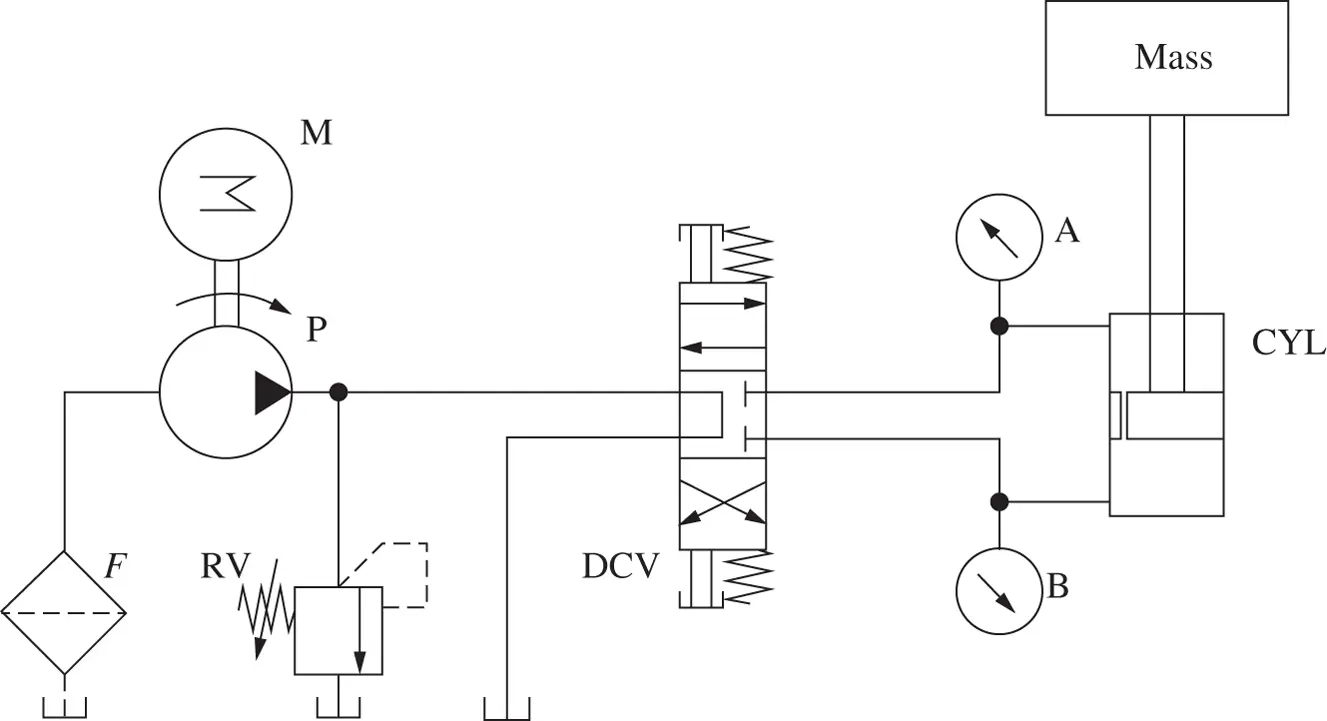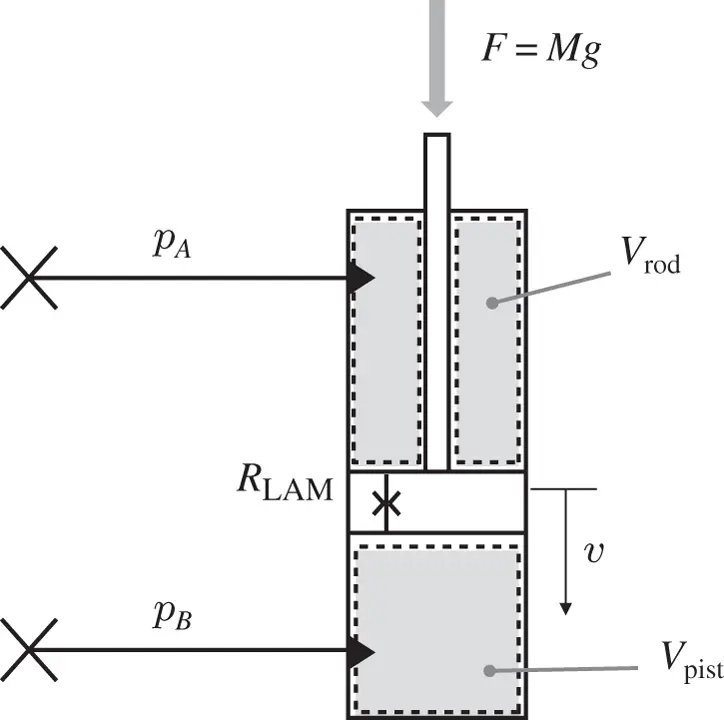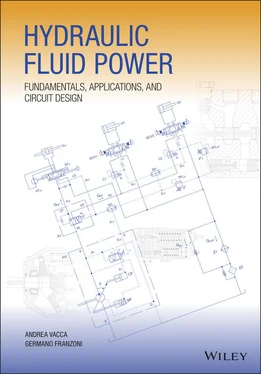
In this condition, the orifice O behaves as a compensator , since it establishes a pressure drop for a given flow rate.
The situation is similar for the smaller opening area Ω 2< Ω 1: the operating point shifts from X1 to X2 at a higher pressure. The relief valve remains closed and the orifice equation can be used again to find p 2.
The orifice maintains the compensator function until it reaches the opening area Ω*. This area value is critical, as it corresponds to a pressure at point P equal to p* . When the opening area is Ω*, the full pump flow is still passing through the orifice.
For area values smaller than Ω*, as in the case of Ω 3, the intersection between the orifice curve and the pump curve would result in the operating point X3′, which corresponds to a system pressure  , greater than p* . As a consequence, when Ω = Ω 3the operating point is defined by the intersection of the orifice curve with the relief characteristic (point X3). In other words, the relief valve opens, relieving a portion of the pump flow to tank, so that the pressure is limited to p P= p *. The flow passing through the orifice is Q 3, while the relief valve discharges the flow Q RV, 3= Q P− Q 3.
, greater than p* . As a consequence, when Ω = Ω 3the operating point is defined by the intersection of the orifice curve with the relief characteristic (point X3). In other words, the relief valve opens, relieving a portion of the pump flow to tank, so that the pressure is limited to p P= p *. The flow passing through the orifice is Q 3, while the relief valve discharges the flow Q RV, 3= Q P− Q 3.
The orifice equation in this case can be used to find the flow rate Q 3, knowing that the pressure drop across the orifice is defined as Δ p 3= p * − p T= p *

A further reduction of the opening area of the orifice (Ω 4< Ω 3) results in a reduction of the orifice flow, as visible by the location of the intersection point X4 in the figure.
In these conditions, the orifice behaves as metering , since it establishes a flow rate as a consequence of a given pressure drop.
This example shows how a metering element can be used to regulate flow in a hydraulic system. In this simple case, the orifice flow is directed to tank at null pressure. In general, an actuator can be located downstream of the metering element, which is ultimately used to adjust its speed.
4.5.2 Orifices in Pilot Lines
Pilot lines are used to transmit the value of pressure to different locations of a circuit. In such lines, it is very rare to find orifices working as metering or compensator devices. Instead,
Orifices are used in pilot lines to manipulate the pressure signal, according to two possible function purposes: pressure separators or dynamic orifices .
A pressure separator is an orifice used to decouple the pressure in the working line – where the pilot line is connected – and the pressure transmitted by the pilot line itself, downstream the orifice.
A dynamic orifice is utilized with to modify the rate at which the pressure information is transmitted through the pilot line. Dynamic orifices dampen the pilot pressure information, acting as hydraulic low pass filters. Typically, dynamic orifices are accomplished with two different layout configurations. In the first layout, they are located next to closed‐end connections of the pilot line. Therefore, they do not affect the operation of the system in steady‐state operation, being crossed by zero flow rate in this condition. This kind of dynamic orifice can be neglected while studying the main steady‐state system operation. In the second layout, the dynamic orifice is used in an additional pilot line connection to the reservoir (bleed orifice). Also, a bleed orifice does not affect the steady‐state operation of the system, but it introduces a constant dissipation by bleeding fluid to tank.
Understanding the function of orifices in working lines and pilot lines is not always simple, particularly for the cases of pressure separators and dynamic orifices. For this reason, this book will often point out the function accomplished by the various orifices present in a certain component or system. In this way, the reader will progressively become more familiar with recognizing the different roles of orifices in hydraulic systems.
Example 4.4Leakage in a Cylinder
Consider the hydraulic system in the figure below. The system is used to lift and lower a vertical load. The system requirement is that no leakage should occur while the system is in rest or standby (directional control valve (DCV) in neutral position). However, the cylinder seal is damaged so that leakages can occur between its piston chamber and its rod chamber. Assuming that the DCV can perfectly block the cylinder work ports, what happens to the piston when the valve is in rest position? Does it fall? Or it remains stand still? Also, provide the value of the reading of the two pressure gages A and B in such condition.
The following data are given: equivalent orifice resistance of the internal cylinder leakage = 50 ( bar · min )/ l ; mass = 1000 kg ; piston diameter 100 mm ; rod diameter 40 mm .

Given:
The hydraulic schematic of a hydraulic lifting system, the piston diameter of the cylinder D = 100 mm and the rod diameter d = 40 mm . The gravitational load is known M = 10 000 kg . The internal leakage of the cylinder expressed as equivalent orifice resistance (Δ p O, LAM= R LAM Q LEAK) R LAM= 50 [( bar · min )/ l ].
Find:
1 The motion of the cylinder in rest condition (vertical velocity)
2 The reading of the pressure gages A and B
The hydraulic schematic of the lifting system considered in this problem introduces the symbolic representation of components that will be described in more detail in the next chapterof this book. However, for the reader, the functioning of the system should be quite intuitive: a hydraulic pump P is driven by a prime mover (an electric motor) M to supply flow to a hydraulic control valve, DCV. The hydraulic control valve is manually activated, and it determines the direction of the supply flow: in one position, it implements the cylinder extension, and in the other, the retraction. Centering springs ensure the valve blocks the cylinder work ports in case of no valve actuation.
A pressure relief valve is installed at the pump outlet, to protect the pump from overpressurization.
Considering the rest position, the supply part of the hydraulic system is isolated through the DCV, so that the problem can be simplified by considering the following schematic:

1 If a motion of the piston would occur in rest conditions the steady‐state form of the conservation of mass at both Vpist and Vrod would apply: (E4.4.1) (E4.4.2)The above equations were derived in Chapter 3, when analyzing the basic functioning of a linear actuator. The flow QLEAK is the flow rate through the laminar orifice that represents the internal leakages inside the cylinder. (E4.4.3)From the above (E4.4.1) and (E4.4.2), being Apist ≠ Arod, it is clear that the only possible solution for the leakage flow is QLEAK = 0 l/min. This means that even if there is an opening between the two chambers of a differential cylinder actuator, there are no internal leakage inside the actuator. This means that v = 0 m/s, meaning that the piston will remain in standstill.
Читать дальше


 , greater than p* . As a consequence, when Ω = Ω 3the operating point is defined by the intersection of the orifice curve with the relief characteristic (point X3). In other words, the relief valve opens, relieving a portion of the pump flow to tank, so that the pressure is limited to p P= p *. The flow passing through the orifice is Q 3, while the relief valve discharges the flow Q RV, 3= Q P− Q 3.
, greater than p* . As a consequence, when Ω = Ω 3the operating point is defined by the intersection of the orifice curve with the relief characteristic (point X3). In other words, the relief valve opens, relieving a portion of the pump flow to tank, so that the pressure is limited to p P= p *. The flow passing through the orifice is Q 3, while the relief valve discharges the flow Q RV, 3= Q P− Q 3.













